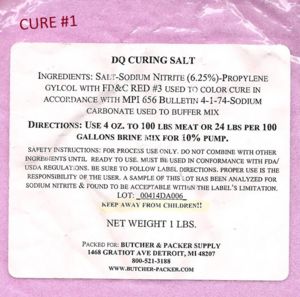Eilta, morning.... It's nice to see folks question what's going on......
First I will address salt....
Salt additions should be weighed to have consistency between types of salt
Salt Type ..........................................Weight of 1/4 cup (grams)
Morton’s Table Salt..................................... 76.0
Morton Pickling Salt.................................... 74.0
La Baleine Coarse Sea Salt.........................66.8
La Baleine Fine Sea Salt............................ 64.8
Morton’s Kosher Salt.................................. 62.0
Diamond Crystal Kosher Salt..................... 45.2
Maldon Sea Salt......................................... 33.2
As you can see, salt density can vary depending on who is processing it... So, volume measurements are not accurate.... A 0-100 grams digital scale will give you very good accuracy... About 12-15$.....
Cure #1.....
Is 6.25% nitrite in the U.S.A.. You must check the % nitrite on the label.....
Measuring spoons are not that accurate... I have 2 sets and there is a 25% difference between them so weigh out your cure also...
PPM is calculated on weight vs. weight....
1 gram put into 1,000,000 grams is 1 PPM.....
1 gram put into 1,000 grams is 1,000 PPM...
156 grams put into 1,000,000 grams is 156 PPM....
~1.12 grams (0.25%) of cure#1 will render ~156 PPM nitrite in 1# (454 grams) of meat....
156 PPM is the magic number the USDA says will safely cure 1# of sausage to prevent botulism bacteria from growing in your sausage and possibly killing you... Botulism bacteria is the deadliest naturally occurring bacteria known to man.... so far....
1.12 grams per pound (0.25% or 0.0025 multiplier) is what to shoot for... this is a "window" for safe curing... there is some leeway on either side of this number...
For whole muscle meats like roasts etc, there are 2 standards....
Dry rub using cure#1.. 200 PPM nitrite.. includes bacon...
Liquid brine curing#1.. 156 PPM and 120 PPM for bacon.... (the bacon standard is surrounded in controversy)... but it's the law if you are a commercial processor...
To make a safe and legal curing brine solution.... based on many commercial processors numbers....
Weigh out the meat in grams....
Weigh out water to = 1/2 the weight of the meat....
So, we may have 1362 grams of meat, ~ 3#, and ~680 grams water = ~2042 grams total weight.... (2042 X 0.25(0.0025) = 5.11 grams cure#1, you will end up with 156 PPM nitrite in the brine and meat, given enough time....
A brine cure starts out with the liquid high in nitrite... given time, equilibrium, the nitrite migrates into the meat muscle... by injecting the meat muscle using the brine cure, equilibrium can be achieved much faster..
Sorry, trying to simplify this, I keep digging myself into the weeds..... My end goal is to have everyone understand what's happening in this process...






